This Valentine Preschool Cutting Practice is a great cutting activity and free printable for Valentine Day cutting. If you’re looking for scissor cutting exercises for preschoolers, you’re not going to want to miss this! They’ll even get to work on their cutting of zig zag lines, too!
This preschool valentine cutting practice will help your preschool children work on dexterity, scissor skills, and is a great fine motor activity, too. This Valentine cutting activities for preschool is perfect for young children and early learners!
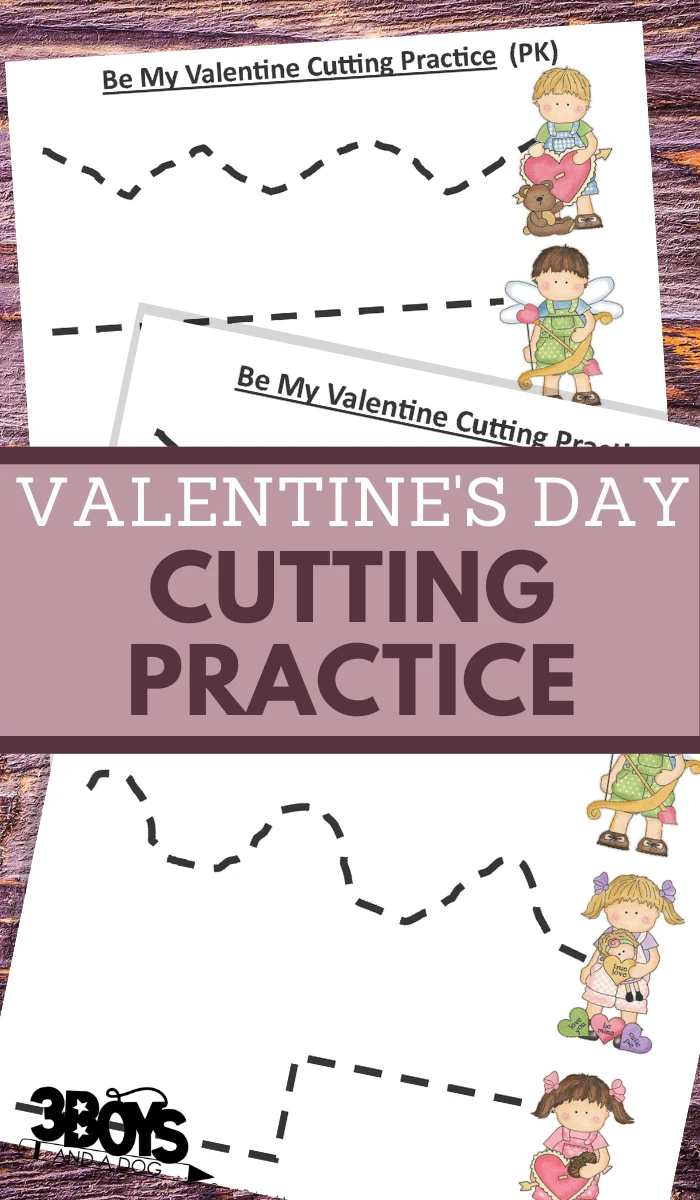
All you need are a few pieces of paper to do these Valentine’s Day cutting worksheets. The kids can use these color, cut, and paste worksheets over and over again. Just because they’re Valentine’s Day themed doesn’t mean that you can’t use them all year long. They’re just perfect for fine motor practice!
What are the fine motor skills used in this printable?
Since the kids will have to use their fine motor skills for their worksheets, they’re not only fun but they’re educational as well. They’ll be using their cutting skills, hand-eye coordination, and direction-following skills, too.
What it includes:
This free printable includes the cutest printable that has dotted lines for your child to cut along and follow the pattern.
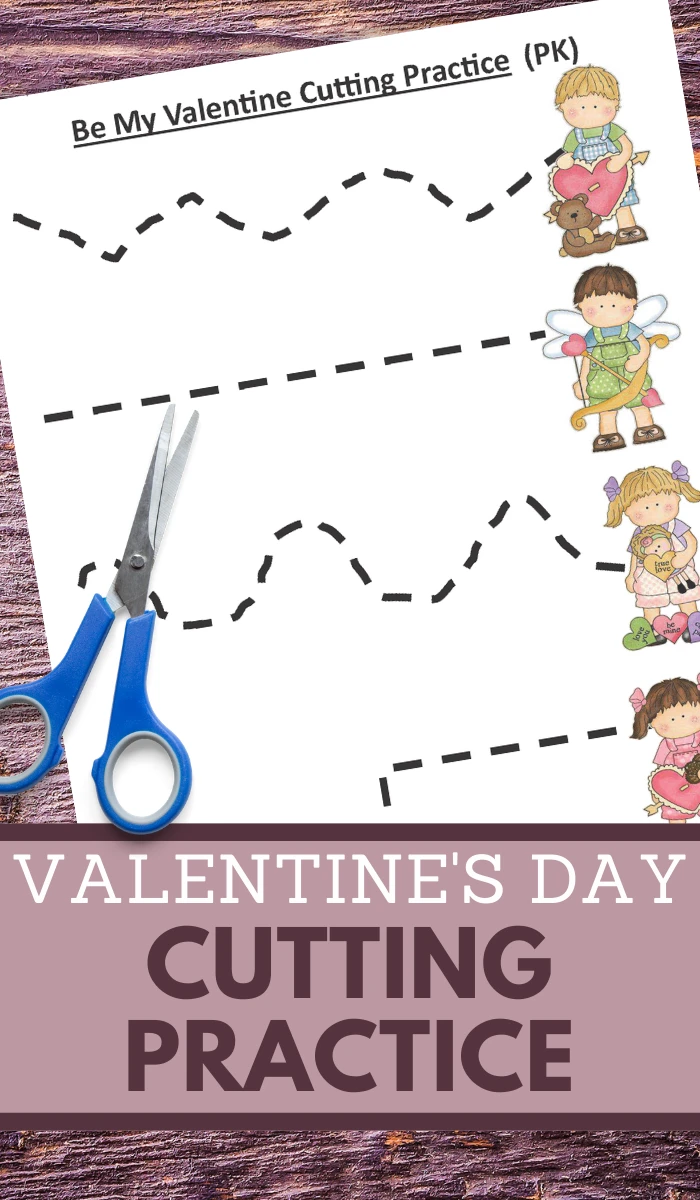
Fun ways to use this printable:
Even though these printable might be pretty straight forward, there are still a few different ways that you can use these printables.
Have them create their own cutting printable
Once they get an idea of how to do this scissor activity, have them create their own to then complete. They’ll love the creativity.
Print and use them again and again
Just because you use these printables one time doesn’t mean you can’t use them again. Have your child trace the pattern on other pages or just print another one to do at home.
Create a story to go along with the cutting practice
Sometimes we all just need a reason to use our imagination. Have your story create a fun story as to why they’re trying to get to the end of the cutting line. You’ll love to hear what they come up with!
Why is cutting practice for kids necessary?
Learning how to cut can help improve fine motor skills in children and support their overall physical development. Regularly practicing cutting can enhance eye-hand coordination, strengthen finger muscles, and promote better grasping techniques.
In addition, continued cutting practice encourages using both hands in unison, developing bilateral coordination — a skill essential for completing many everyday tasks.
By cutting shapes and lines, kids acquire problem-solving strategies that they can apply to their education, such as geometry or art classes.
Moreover, involving kids in cutting activities at an early age encourages independence and exploration of the environment, improving their knowledge of the world around them.
Overall, teaching kids how to sharpen their scissor technique is essential for advancing their physical and intellectual well-being.
How do themed worksheets help with early learning?
Themed worksheets are a great tool to help children learn critical educational fundamentals in an engaging and fun way. They help reinforce the content being taught and provide an element of novelty that is especially helpful for young learners.
Themed worksheets can also support visual learning by providing relevantly-themed illustrations and symbols, as research suggests that these aid in associating words with experiences.
Moreover, themed worksheets present material in a contextualized manner which assists the development of comprehension and problem-solving skills by teaching children how to see the big picture.
In summary, themed worksheets are a valuable asset in early learning education.
What type of scissors is best for preschoolers to use?
Preschoolers need scissors with rounded safety tips to prevent any unintentional injuries. Scissors suitable for this age group should be designed with wide handles and lightweight materials, such as plastic or stainless steel.
This will enable them to grip their scissors securely and cut more effectively. For extra safety, look for scissors with extra finger rests and a spring-loaded handle.
Furthermore, it is beneficial if the blades are dull so children cannot cut anything that can cause harm.
If possible, find a pair of scissors that matches each child’s hand shape.
This way, they should be able to work comfortably for prolonged periods without straining or experiencing cramps in the hands and fingers.
How often should fine motor activities be included in learning for kids?
Fine motor activities should be integral to a young learner’s day, as they have numerous educational benefits.
Repetitive activities that help develop coordination and small muscle control are important prerequisites for writing and other more complex skills such as handwriting.
Integrating fine motor development into a child’s learning program helps them become better problem solvers, enhances their creativity, and may promote bonding experiences when the activities are shared with peers or adults.
Fine motor activities should be included regularly throughout the school week in either structured lessons or informal play-based experiences.
Ideas for activities might include lego building, weaving scarves out of yarn, threading beads on a string to make jewelry, and constructing with clay and paper collages.
Different ages require different levels of complexity, so it is essential to consider age-appropriate tasks when planning fine motor sessions at home or school.
Valentine Learning Activities
Check out the fun Valentine’s Day-themed learning activities in my shop!



What are some other fun-themed learning ideas for early learners?
Early learning is a critical stage in the development of young children, and it should be approached with creativity, innovation, and fun! Themed learning activities offer a unique way to bring more interest and excitement to the classroom.
From stories about friendship in Disney’s Frozen to counting with sea creatures using ocean-themed materials, there are plenty of exciting opportunities for kids to learn through immersive play experiences.
More imaginative ideas could include field trips to relevant places – like trips to an apple orchard during Fall for lessons about nature or visiting an art gallery for culture education.
Through integrating themes into their studies, children can start to make meaningful connections between topics, helping them develop essential analytical skills as they grow.
Themed learning experiences allow teachers to diversify the classroom experience further and create engaging activities catering to all learners.
What are the best tips for helping a child learn to use scissors safely?
Using scissors responsibly and safely is an important skill for young children to acquire. To enable children to become comfortable and skilled in using scissors, parents can guide by encouraging a few simple practices.
Firstly, it is important to ensure that the scissors chosen for the child’s use are age-appropriate and adjustable.
Secondly, both the parent and child must understand how to use the scissors correctly and keep their fingers away from the blade whenever necessary.
Additionally, the parent should help the child familiarize themselves with activities conducted away from the blades, such as gently squeezing a pair of plastic tweezers or poking objects with blunt sticks.
Ultimately, when introducing a child to scissors, safety, patience and practice are key components for helping children develop a strong understanding of responsible scissor use.
More Valentine Printables:
- Printable Sea Creatures Valentine Cards for Kids
- Printable Cactus Valentine Cards for Kids
- Valentines Day Lesson Plans
- Handmade Valentine Greeting Cards

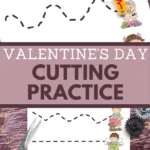
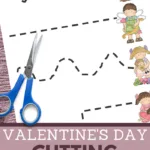

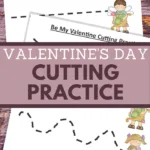





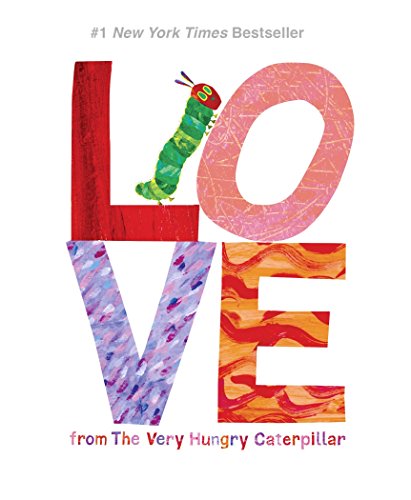











There Was an Old Lady Who Swallowed a Rose Printables - CrystalandComp.com
Friday 24th of February 2023
[…] Valentine Cutting Practice […]
Bridget
Thursday 27th of January 2022
I keep trying to get the cutting sheets emailed to me and they never come :( I have filled it out 3 or 4 times. I have gotten other ones but for some reason I cannot get this one. Help!
Kelli Miller
Saturday 26th of March 2022
email me at kelli(at)3boysandadog(dot) com with the email addy you are using and the printable you are trying to receive. I will look into my delivery system to try to determine the problem.
Anti Korupsi
Friday 18th of April 2014
Apa yaոg saya dapat dari artikel inni sungguh bermanfaat untuk kami. Pujji Syukur, kami yakin pada artikel selannutnya pasti leƄіh menarik lagi. Sukses untuk Anda.
social media expert
Sunday 13th of April 2014
We're a group of volunteers and starting a new scheme in our community. Your site offered us with valuable information to work on.
You have done an impressive job and our entire community will be thankful to you.
leslie
Wednesday 12th of February 2014
Congratulations...this post was featured on Create It Thursday #41! Thanks for sharing such a great idea with us last week!
Kelli Miller
Sunday 16th of February 2014
YAY!! Thank you so much!!